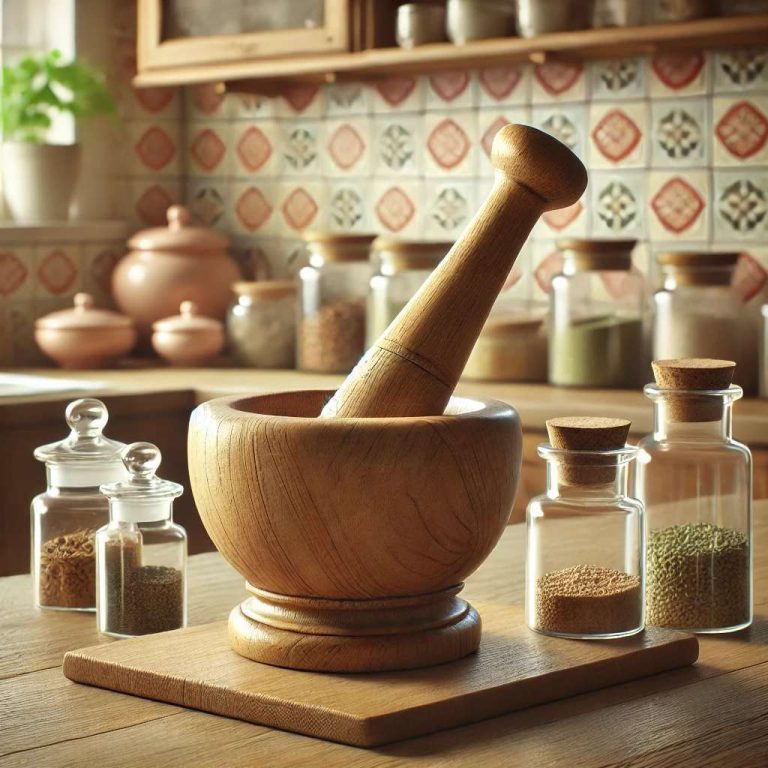Refreshing Ways to Use Cacti in Small Bathrooms for a Zen Spa Vibe
The modern bathroom has evolved from a purely functional space into a personal wellness retreat—a mini spa tucked away in your own home. In an age where mindfulness and minimalism are gaining momentum, homeowners and renters alike are embracing nature-inspired decor to foster tranquility and escape the daily grind.
Among the rising stars in biophilic design is the humble cactus. Once limited to southwestern-style interiors, these resilient plants are being reimagined as design staples, especially in small bathrooms where their sculptural simplicity brings both aesthetic balance and low-maintenance beauty. This guide explores how cacti can transform even the tiniest powder room into a Zen oasis—visually, emotionally, and spiritually.
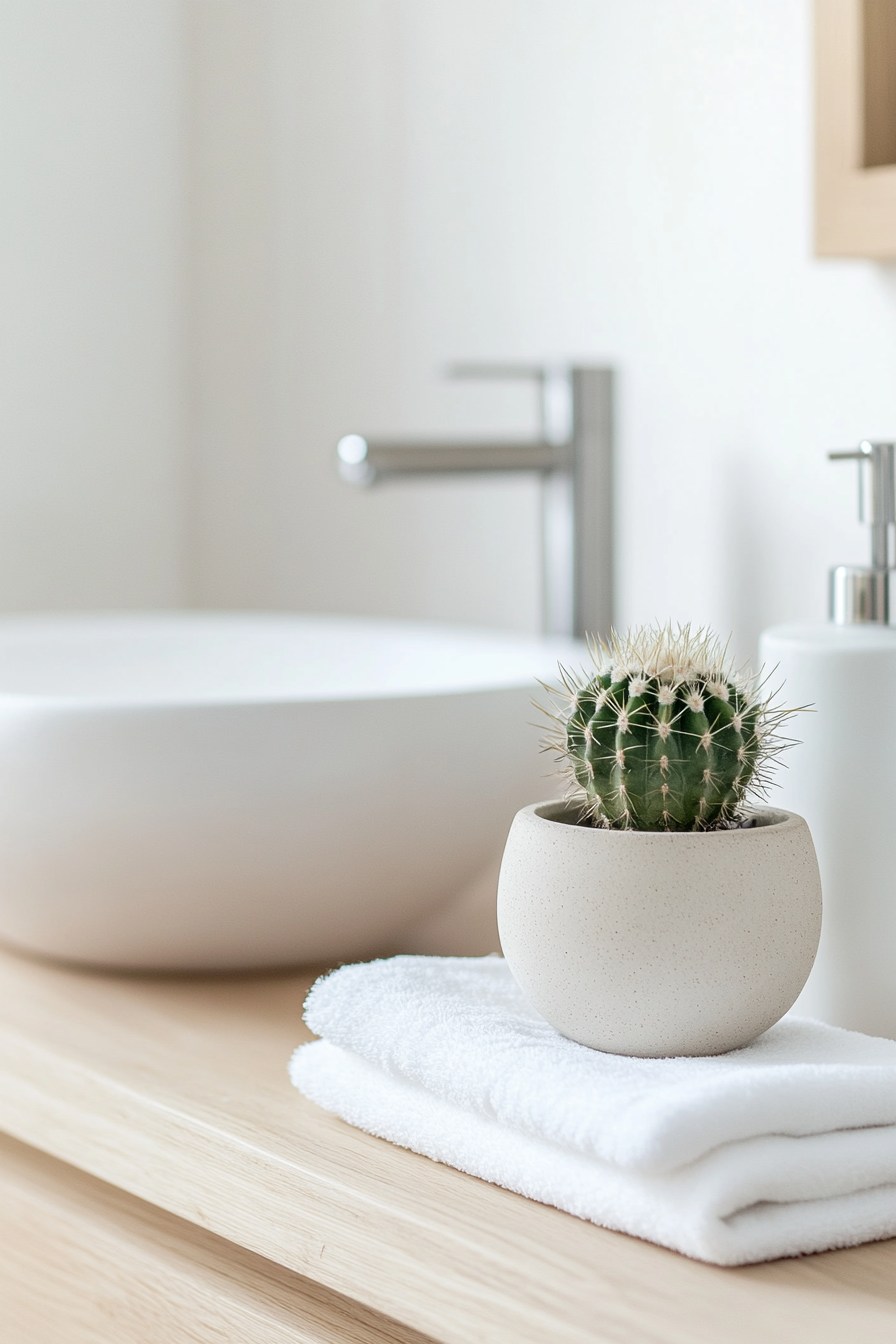
Why Cacti Work Well in Bathrooms
Cacti are often associated with arid deserts, but they’re surprisingly well-suited to indoor environments—especially humid ones like bathrooms. While they don’t thrive in constant moisture, many cactus varieties prefer occasional humidity and can adapt well to the intermittent steam of showers, as long as they’re not soaked.
These hardy plants are incredibly resilient and perfectly suited for people who may not have the time or skill to care for more finicky houseplants. Their symmetrical forms and unique textures are visually calming—essential traits for creating a Zen atmosphere.
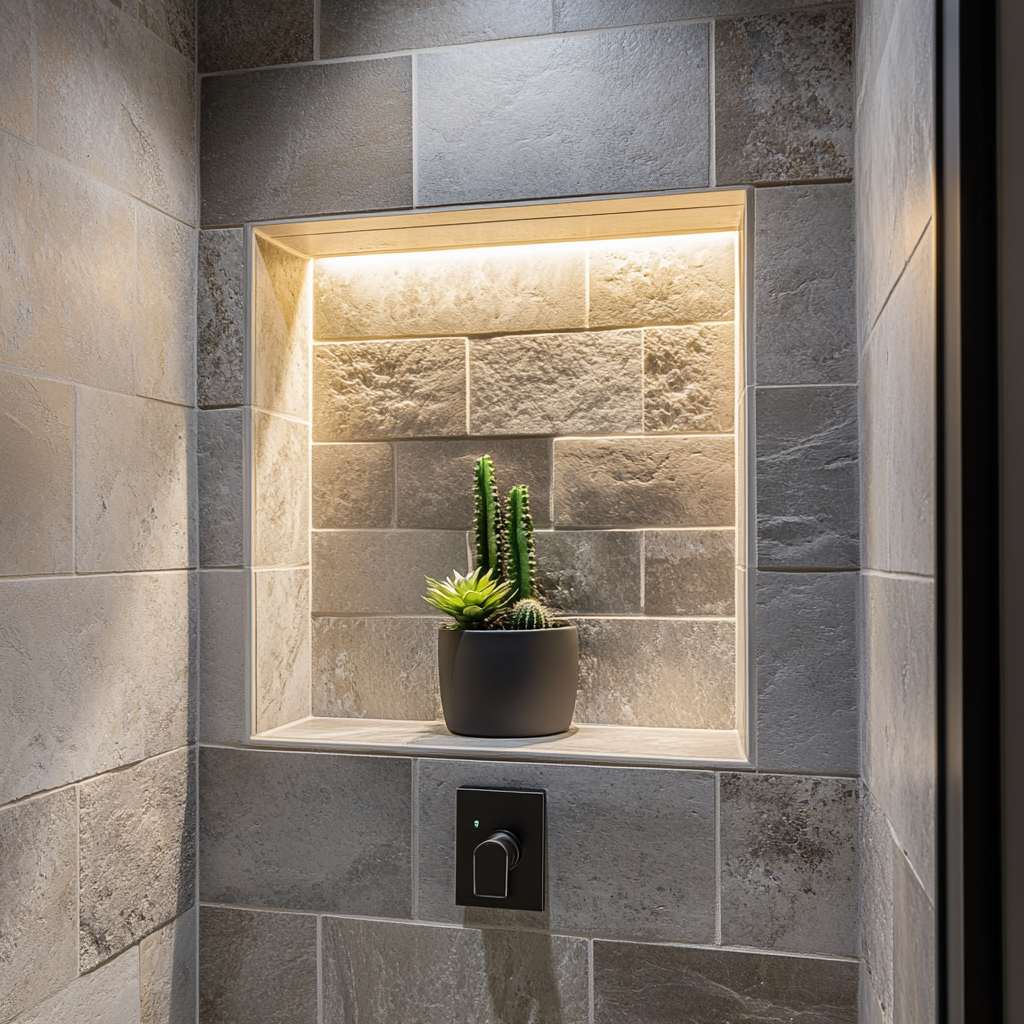
Key benefits:
- Low maintenance: No daily watering, no pruning, and fewer pest issues.
- Air purification: While not as potent as leafy plants, certain succulents aid in filtering air.
- Mood-boosting presence: Studies show that houseplants reduce stress and improve cognitive function—even more so when they’re visually appealing.
Choosing the Right Cacti for Your Bathroom
Not all cacti are created equal—especially when it comes to humid, low-light spaces like bathrooms. Choosing the right species can mean the difference between a thriving plant and one that quickly decays.
Compact, soft-spined varieties that love indirect light are your best bet. These types are less prone to accidents in tight quarters and won’t overwhelm the visual flow of a small bathroom.
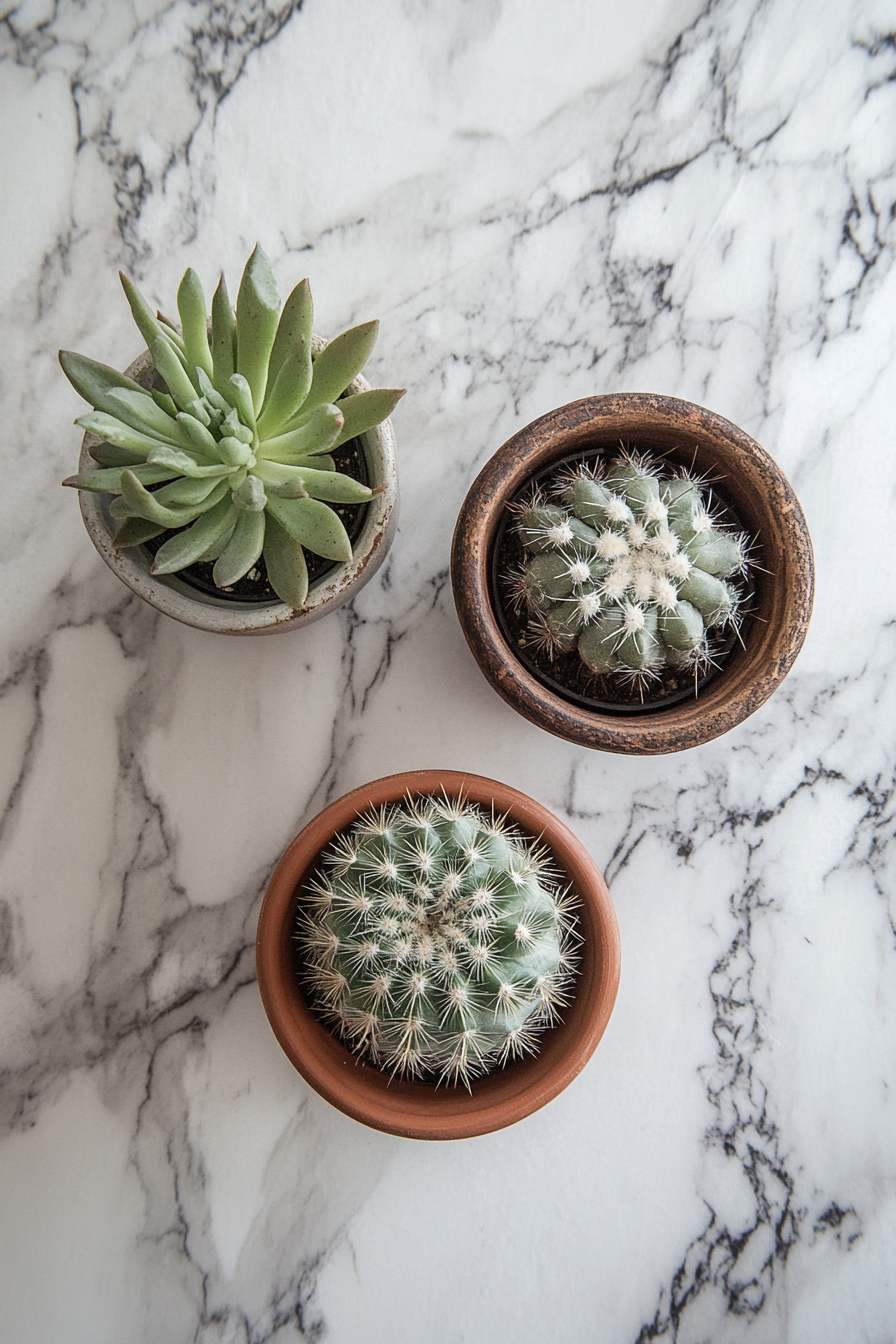
Recommended species:
- Mammillaria: Compact and spherical, these are great for small pots and often bloom with small pink flowers.
- Rebutia: Miniature globe-shaped cactus with radiant orange or red blossoms.
- Haworthia (technically a succulent): Thick, striped leaves and very tolerant of low light.
- Gymnocalycium: Known for their colorful flower heads and minimal spines.
Species to avoid:
- Tall columnar cacti like Cereus—they’re prone to tipping and require more light.
- Opuntia (prickly pear): Their glochids (tiny spines) can cause skin irritation.
- Euphorbia species: Often confused with cacti, but they release irritating sap.
Zen Principles in Small Bathroom Design
Zen philosophy emphasizes balance, simplicity, and harmony with nature. These principles can be beautifully expressed in a small bathroom, where clutter is banished and every object is intentional.
Zen Design Fundamentals:
- Simplicity: Use neutral palettes, streamlined fixtures, and natural materials.
- Mindful space: Leave room for “emptiness”—negative space is just as important as filled space.
- Nature integration: Wood, stone, water, and plants offer grounding elements.
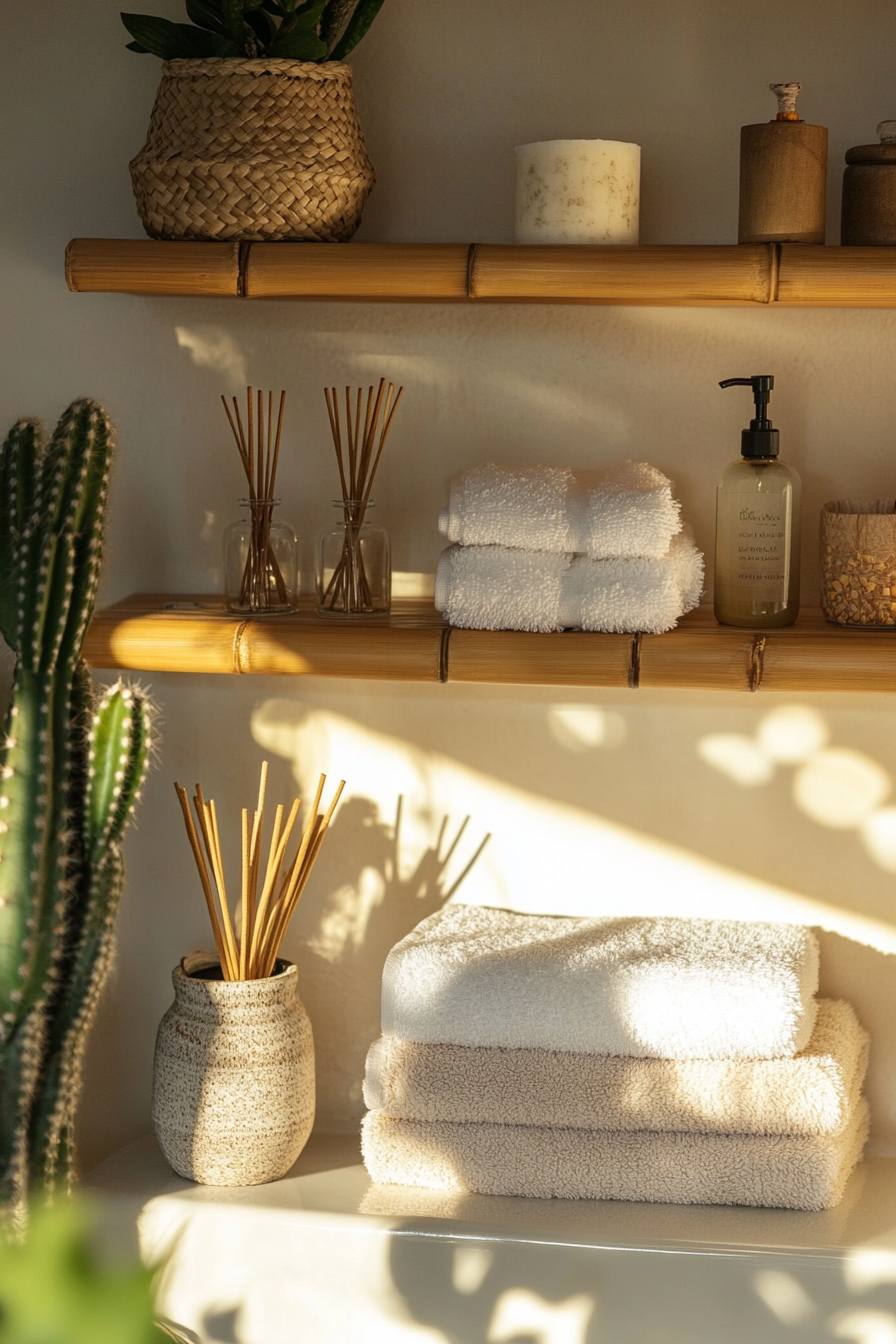
Adding a cactus to this environment reinforces these values. Its structured, organic form enhances the spatial rhythm, while its stillness promotes quiet introspection.
Strategic Placement Ideas for Cacti
Smart placement is essential in small bathrooms. Whether you’re working with a pedestal sink or a corner vanity, every square inch counts. Cacti offer sculptural beauty without overwhelming your layout.
Suggested placements:
- Windowsills: Perfect for light-loving cacti.
- Wall niches or recessed shelves: Built-ins offer elegant stages for display.
- Back of the toilet: Ideal for a single potted cactus in a ceramic container.
- Corner ledges: Use small triangular shelves to make use of tight corners.
- Floating vanities: Add a low pot beside a soap dish or lotion bottle.
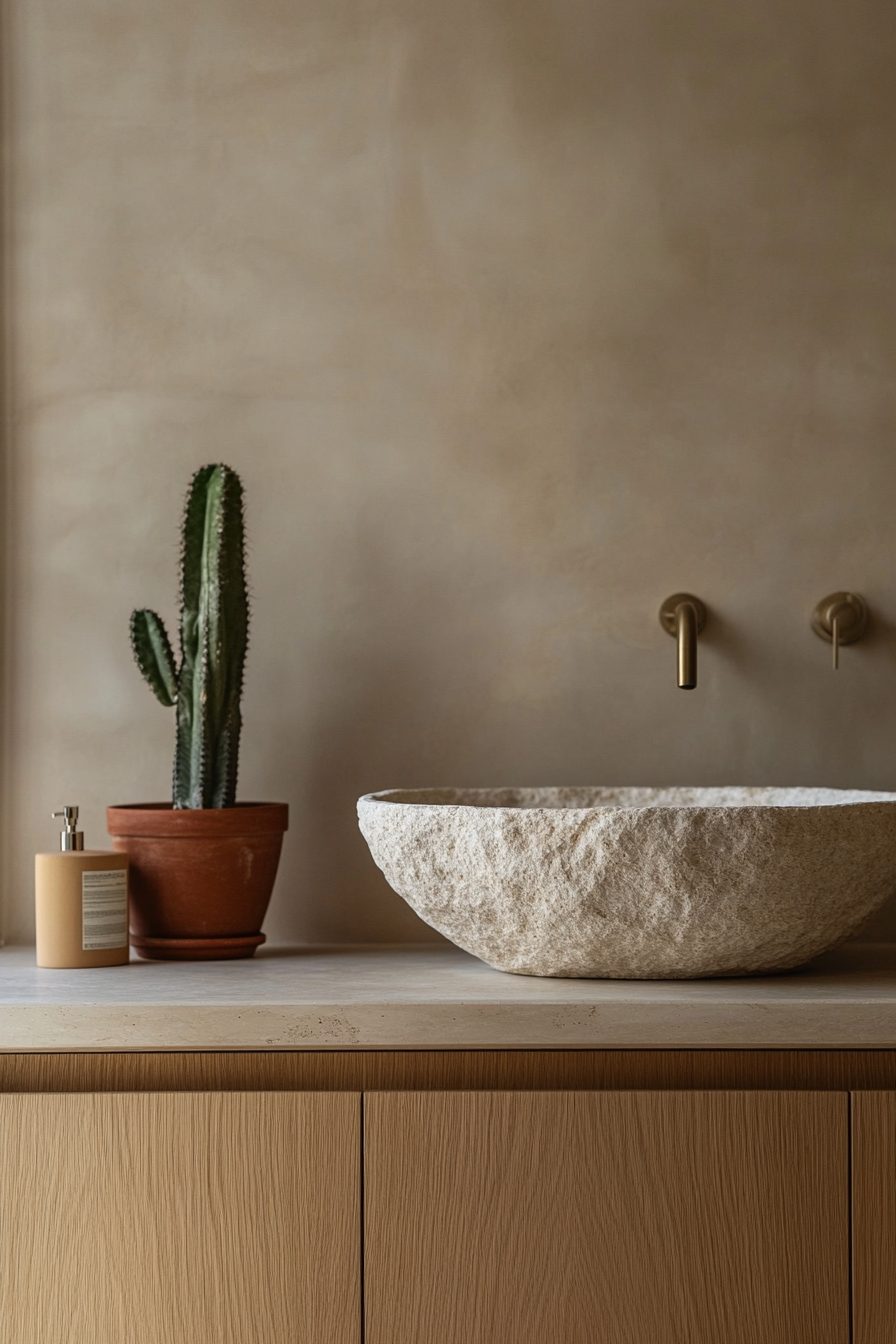
Mixing heights and textures—like rough stone with smooth ceramic—enhances visual flow.
Hanging Cacti and Vertical Displays
Vertical decor is a game-changer in small spaces. Hanging cacti not only conserve counter space but also elevate the entire design.
Vertical styling ideas:
- Macrame hangers: Add Bohemian elegance; best for trailing cacti like Rhipsalis.
- Wall-mounted shadow boxes: Install shallow shelves to host small potted plants.
- Vertical wire frames: Hang small planters on a grid for a “living wall” effect.
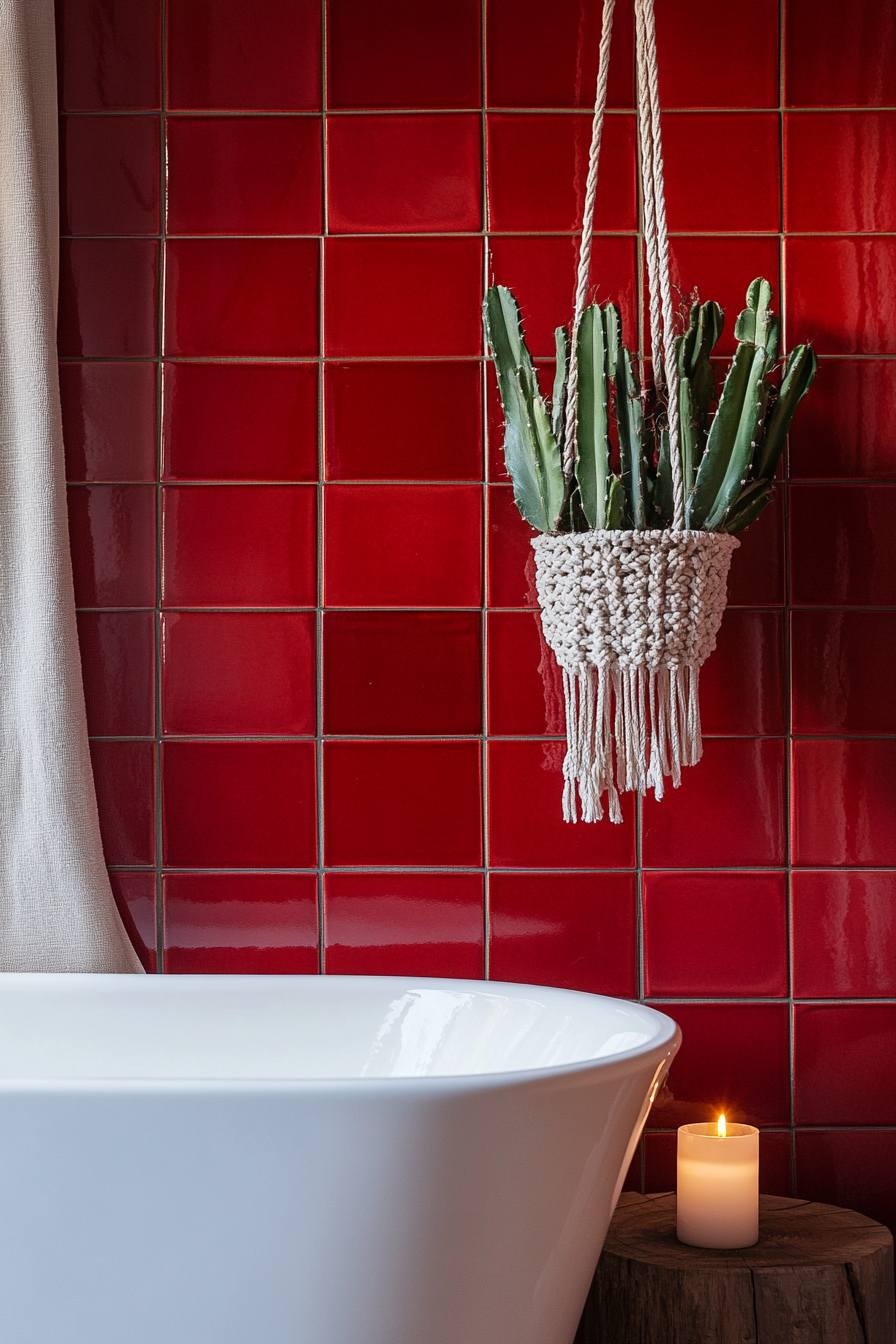
Use balance when hanging plants—group odd numbers together and vary lengths for harmony. Always ensure any fixtures you use are moisture-resistant and securely fastened.
Cactus Terrariums for Spa Ambience
A well-crafted terrarium turns your cactus into a mini landscape—perfect for countertops or window ledges. These self-contained ecosystems feel alive and meditative and are a great DIY weekend project.
Steps to build your terrarium:
- Start with a glass vessel—open-topped is better for airflow.
- Add layers: pebbles → activated charcoal → cactus soil.
- Position mini cacti and add moss, sand art, or mini stones.
- Optional: Incorporate tiny Buddha statues, driftwood, or miniature bamboo stalks for spa-like theming.
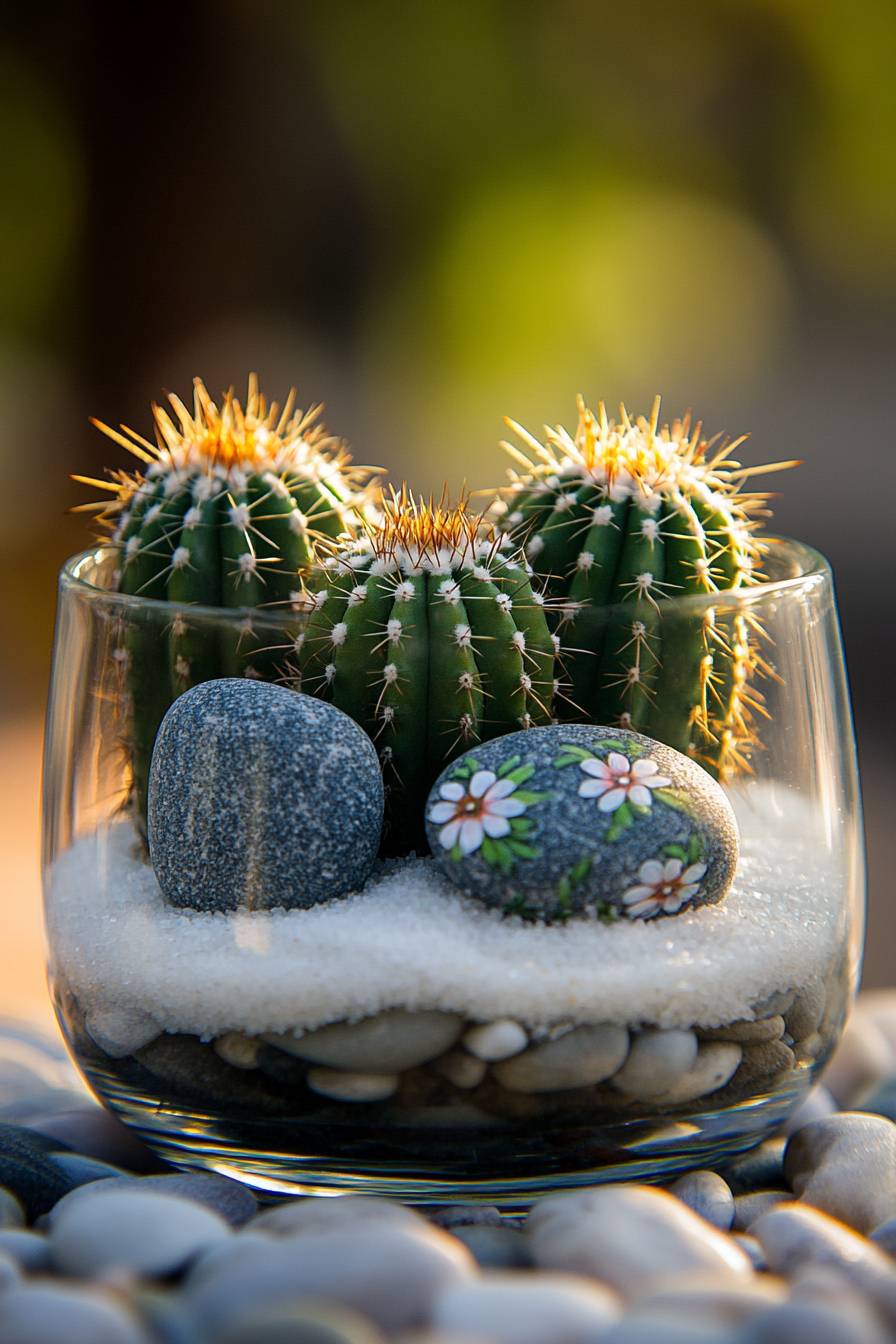
Terrariums invite mindfulness. They act as miniature meditative gardens you can tend to gently.
Using Cacti as a Focal Point
A cactus can easily become the star of your bathroom’s design—its unique form and texture catch the eye and set the tone.
Tips for effective display:
- Place on a tray with candles, oils, and smooth stones for a serene vignette.
- Surround your mirror with symmetrical cactus placements.
- Use spotlighting or shelf LEDs to highlight form and shadow.
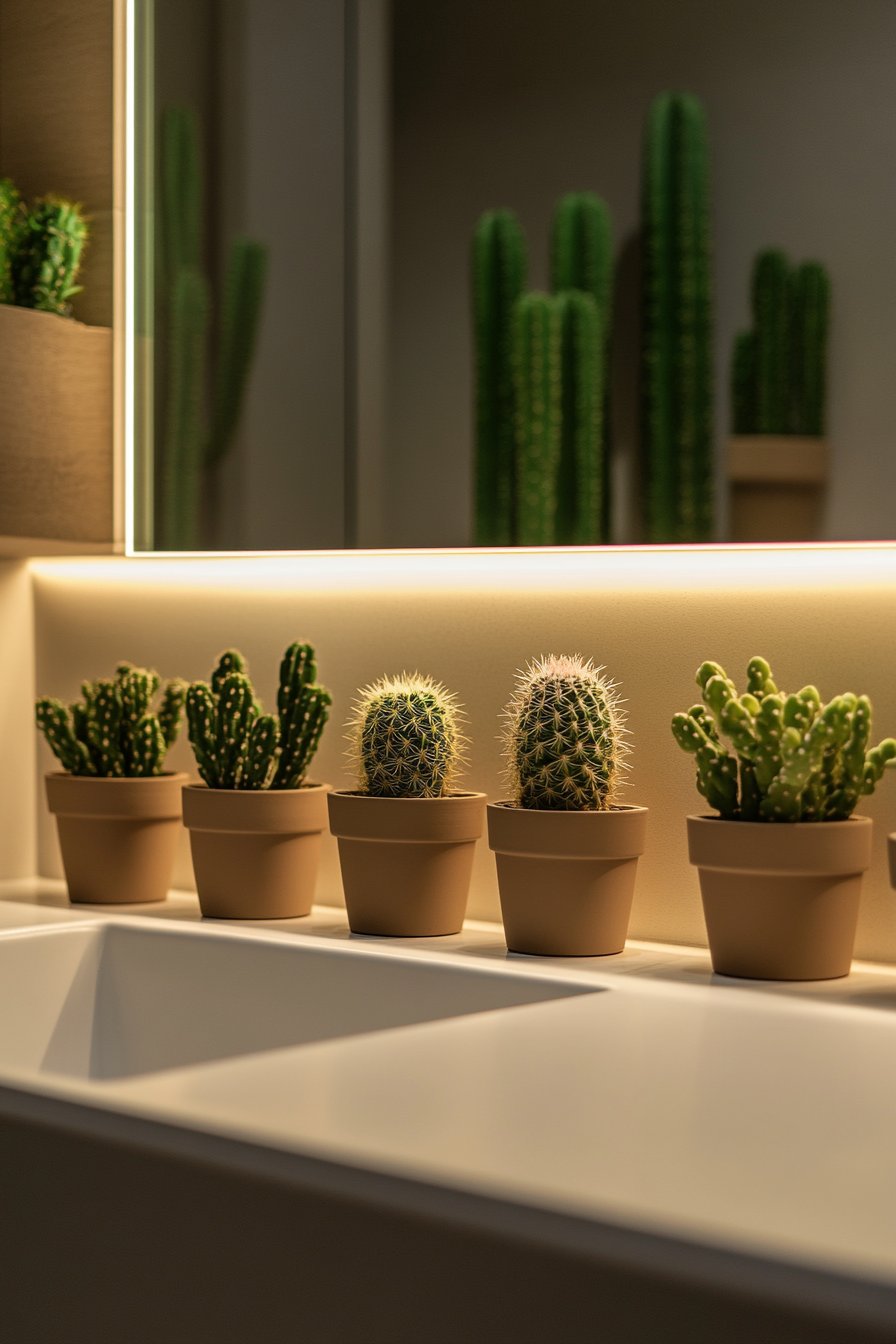
The trick is to use your cactus to ground the design without overwhelming the space. One or two sculptural plants are more impactful than a cluttered cluster.
Coordinating with Spa-Like Accessories
To complete the Zen effect, pair your cacti with accessories that encourage relaxation and ritual. The goal is to transform a utilitarian space into a sensory retreat.
Suggested pairings:
- Rolled towels in stone or bamboo trays.
- Candle groupings using essential oils like cedar or lemongrass.
- Woven textures like rattan baskets and seagrass mats.
- Bamboo soap dispensers, neutral-toned ceramics, and stone coasters.
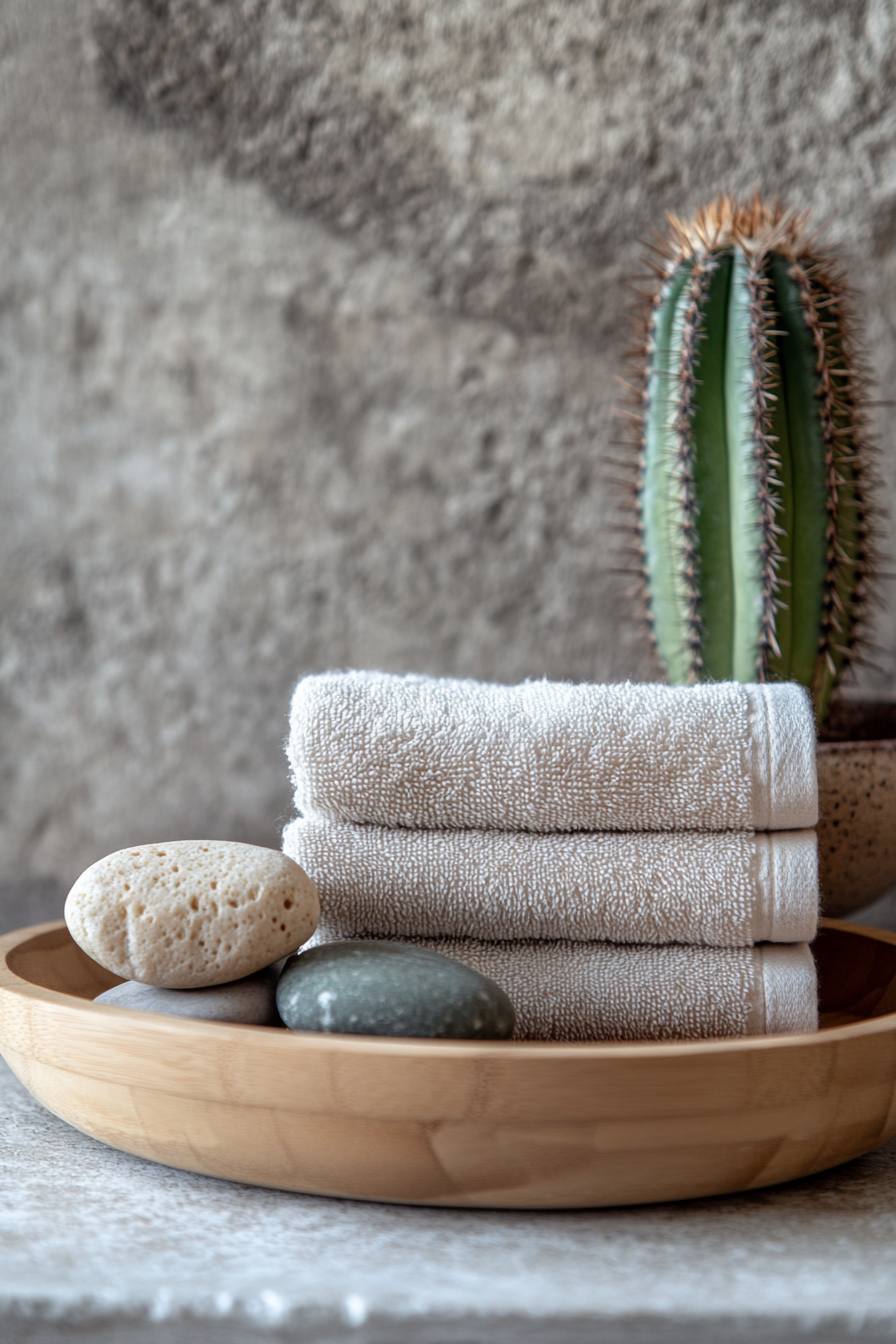
Combining natural materials and subtle greenery creates a relaxing, cohesive aesthetic.
Small Cactus Gardens for Window Ledges
Your windowsill can become a stage for natural beauty. A tray garden brings intentional design to a linear space and is easy to rotate and refresh with the seasons.
Design tips:
- Use a wooden or ceramic tray for containment.
- Arrange 3–5 mini cacti in odd numbers for visual interest.
- Add decorative sand, black pebbles, or driftwood for texture.
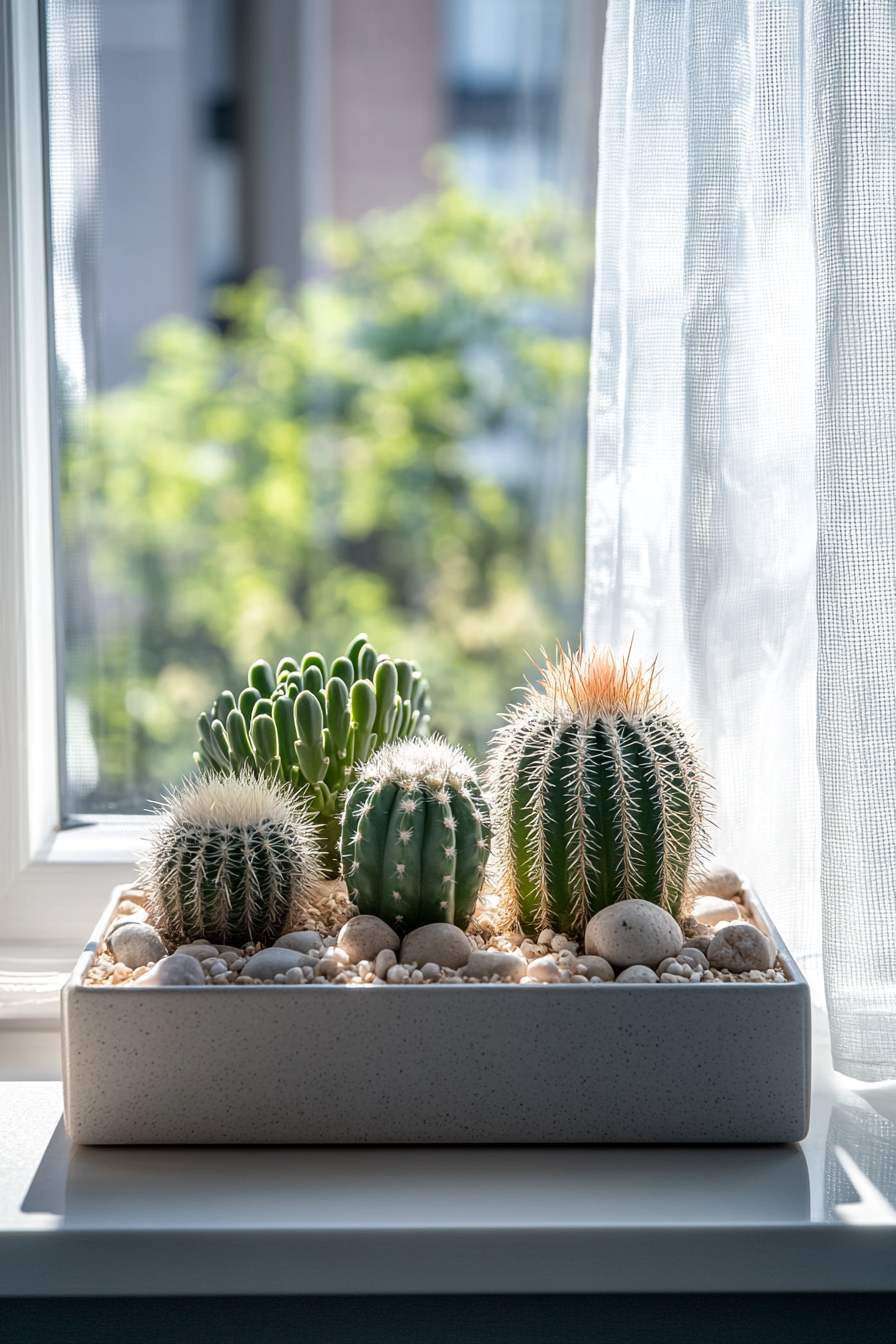
Layering is essential—place the tallest cactus in the back and arrange others by descending height for flow.
Lighting Cacti for Maximum Effect
Lighting is critical not only for plant health but for setting mood. Even bathrooms with limited natural light can creatively illuminate plants.
Lighting tips:
- Natural light: South or east-facing windows are ideal.
- Grow lights: If no windows are available, a small LED grow light can suffice.
- Accent lighting: Install LED strip lights under shelves or within niches.
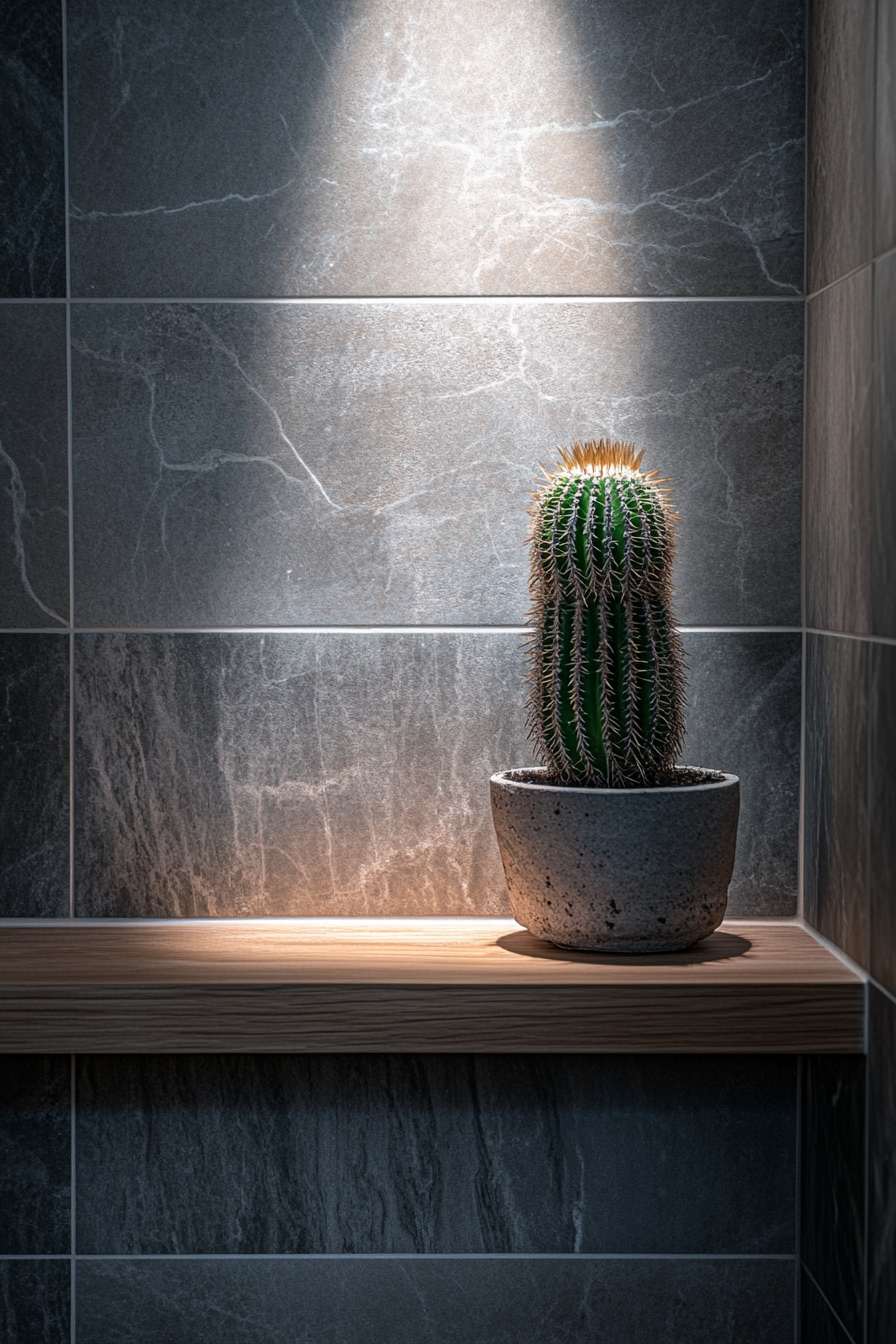
Choose warm tones (2700K–3000K) for evening calm or daylight bulbs (5000K) for energizing mornings. Highlighting cacti adds dimension and artistic flair.
Cactus-Printed Décor as an Alternative
Not everyone can keep live plants, whether due to allergies, pets, or lifestyle. That doesn’t mean you can’t enjoy the cactus aesthetic.
Creative options:
- Framed cactus photography or pressed botanical prints.
- Towels, bath mats, or curtains with subtle cactus patterns.
- Cactus-patterned wallpaper, peel-and-stick murals, or decals.
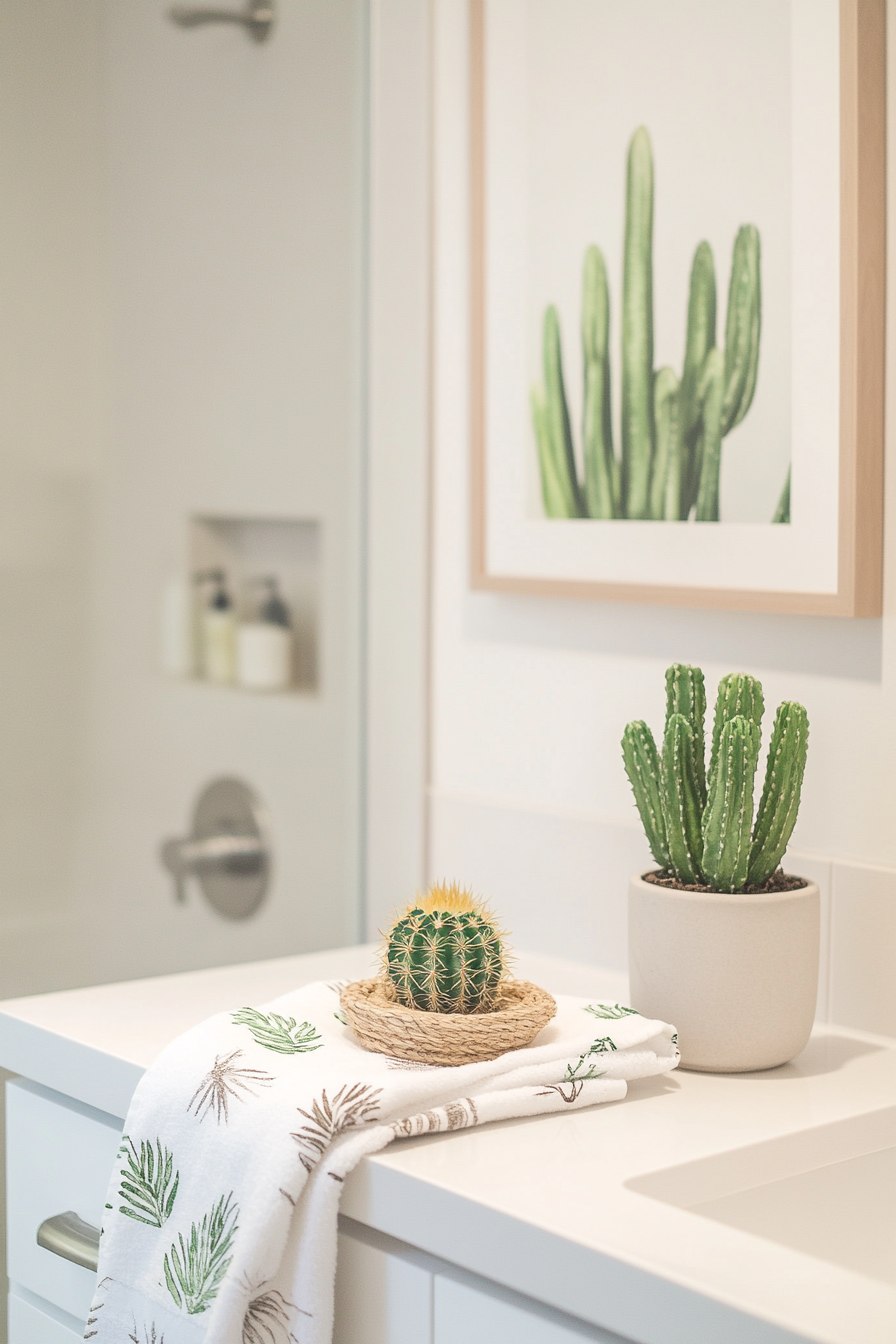
Choose high-quality, minimalist prints that complement your color palette rather than overwhelm it.
Maintaining Your Bathroom Cacti
While cacti are low-maintenance, they still need proper care—especially in fluctuating humidity.
Maintenance tips:
- Water every 2–3 weeks only when the soil is bone dry.
- Use terra cotta pots with drainage to prevent root rot.
- Avoid misting, which can encourage mold.
- Check regularly for pests like mealybugs or mold growth on the soil surface.
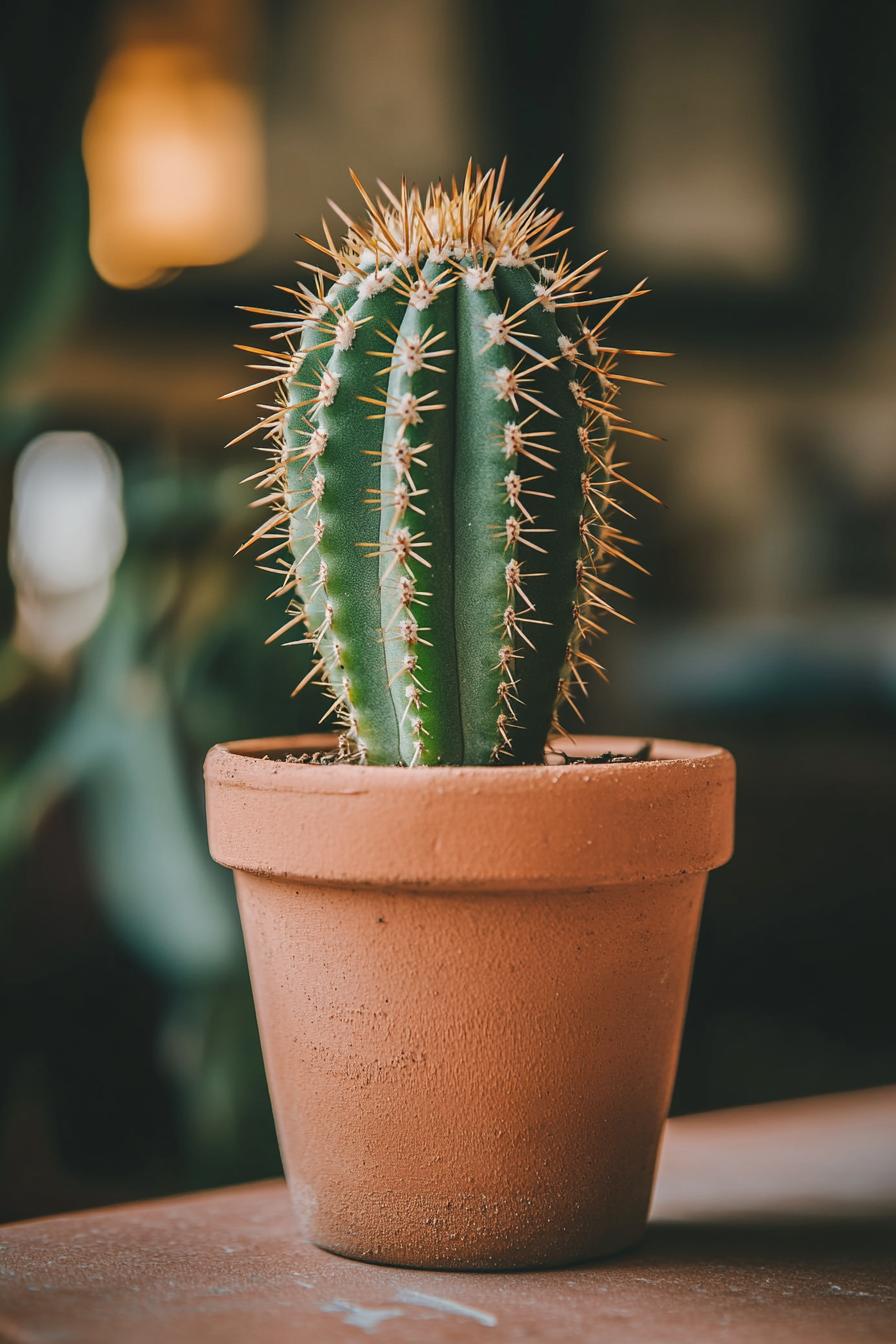
Healthy cacti are firm, upright, and deeply colored. Yellowing, softness, or shriveling indicates trouble.
Seasonal Care and Rotation
Even indoor cacti follow natural cycles. Adjusting their care with the seasons keeps them strong and resilient.
Seasonal adjustments:
- In spring/summer: Rotate for even sun exposure and water more frequently.
- In fall/winter: Cut watering in half and reduce light exposure to simulate dormancy.
- Occasionally move plants to other rooms with better lighting to refresh their growth.
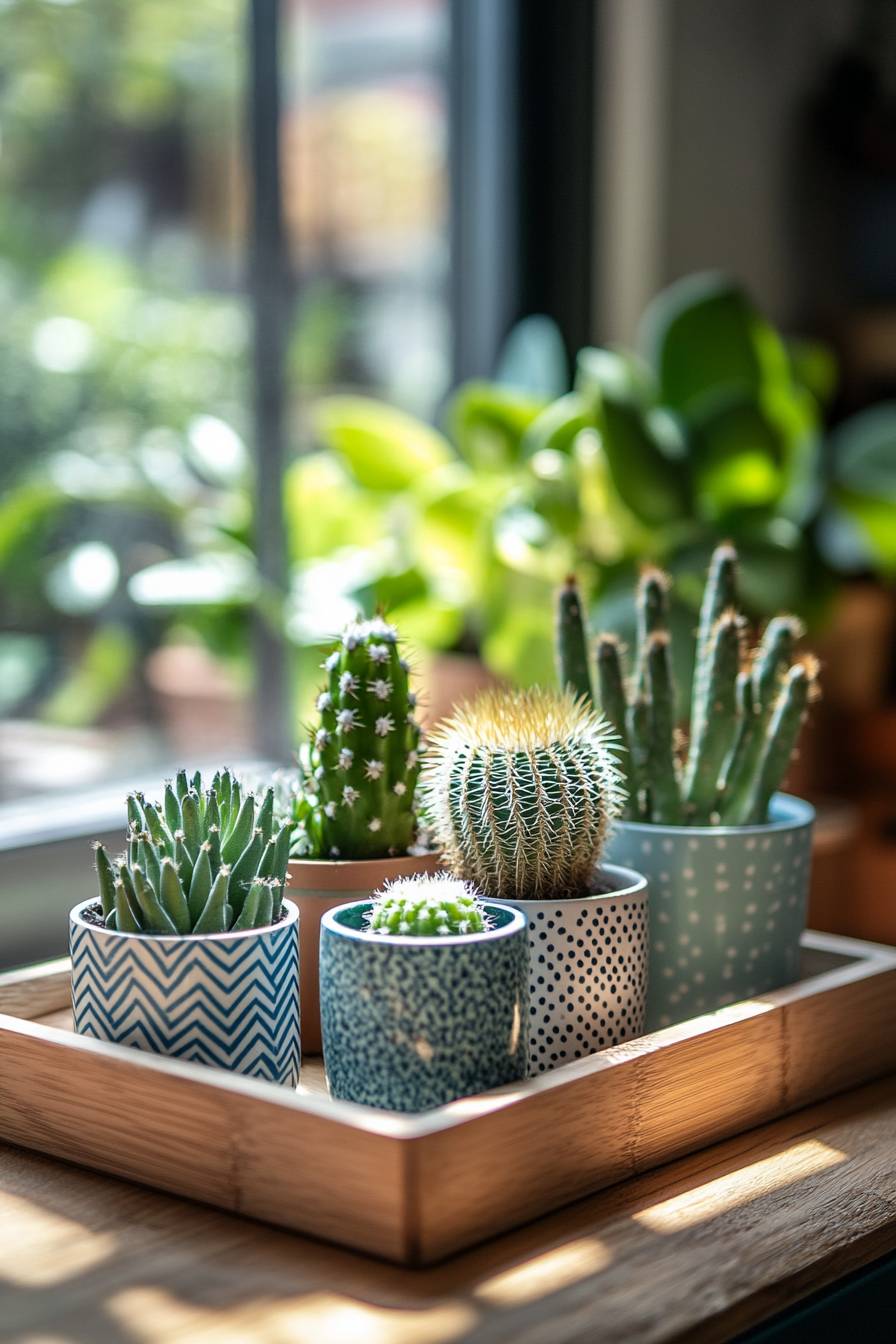
This rotation mimics their native habitat conditions and can boost flowering in spring.
Blending Scents and Plants for Full Spa Experience
The bathroom is an ideal place to engage all the senses. Pair your cacti with calming scents to deepen the spa-like feel.
Recommended scent pairings:
- Lavender or chamomile for stress relief and sleep support.
- Eucalyptus or mint for clarity and a clean scent.
- Cedarwood or sandalwood for grounding and warmth.

Use candles, incense, or diffusers with natural essential oils to maintain a pure and subtle scent profile.
Mistakes to Avoid with Bathroom Cacti
Even though they’re easy-care, there are common mistakes that can ruin a cactus’s health or diminish its decorative impact.
Mistakes to avoid:
- Overwatering: Bathroom humidity can trick you—wait until the soil is dry to the touch.
- Poor drainage: Pots without drainage holes cause root rot.
- No light: Even low-light cacti need some brightness to survive.
- Crowding: Avoid cluttering too many decorative items in a small space.
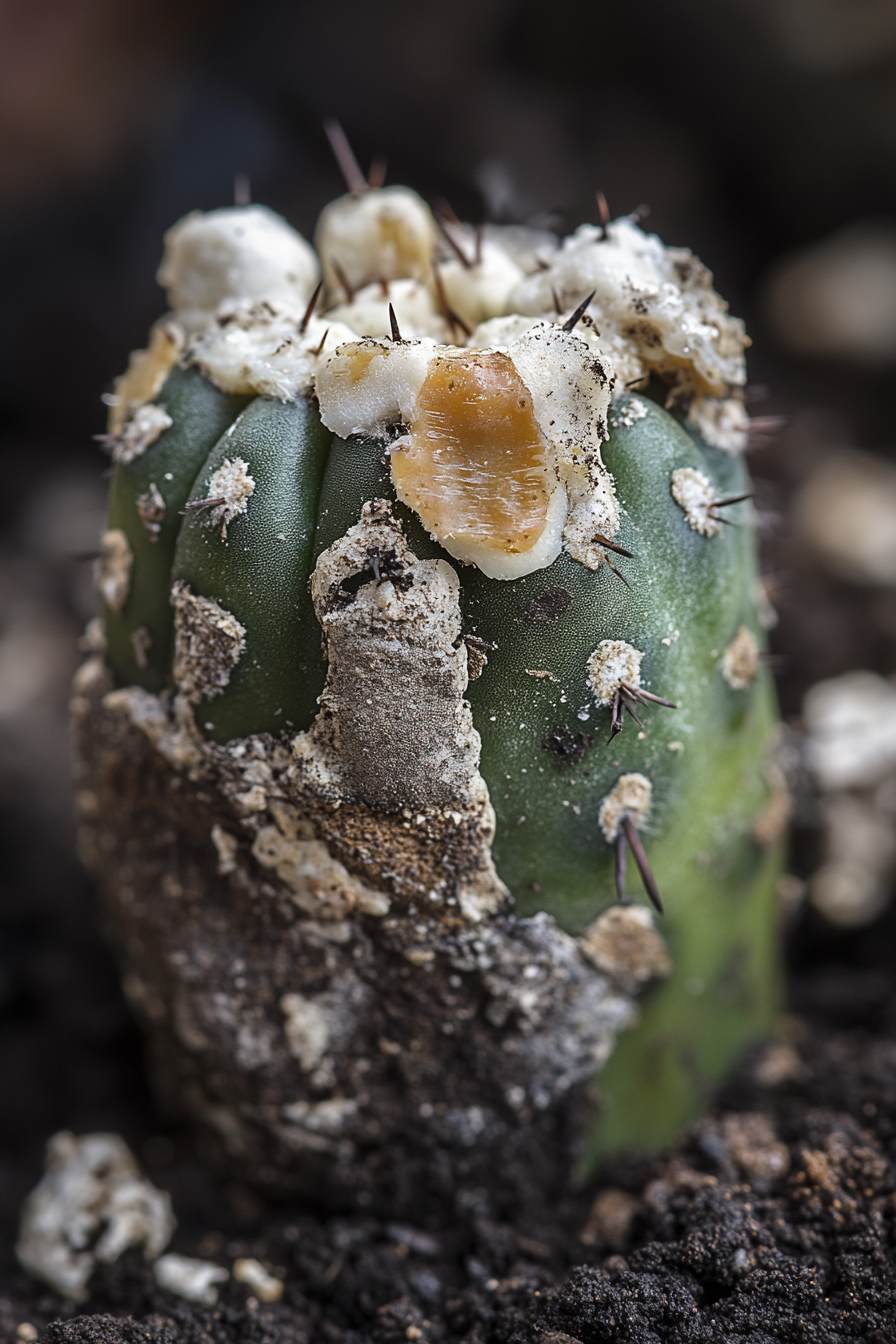
When in doubt, simplify. One healthy cactus in a beautiful container can elevate the entire room.
Real Bathroom Transformations Featuring Cacti
Looking for proof of concept? Real homeowners have found success using cacti to beautify their bathrooms.
Examples include:
- A dull guest bathroom transformed into a spa escape with floating wood shelves, LED lighting, and three symmetrical cactus pots.
- A tiny studio apartment bathroom enhanced with cactus-themed art and vertical planters.
- A budget-friendly DIY makeover where $200 went toward secondhand accessories, cactus terrariums, and bamboo accents.
Cacti consistently deliver visual interest, tranquility, and ease of maintenance, making them a perfect tool for small-space transformation.
Conclusion
Adding cacti to your small bathroom isn’t just about aesthetics—it’s a lifestyle upgrade. These resilient, elegant plants bring a calming presence, require minimal upkeep, and naturally align with Zen design principles.
Whether you choose one striking specimen or craft a mini cactus garden on your windowsill, you’re tapping into a centuries-old tradition of using nature to enhance peace, wellness, and mindfulness. Let your bathroom become your sanctuary—one cactus at a time.
FAQ
Can cacti really survive in bathrooms with no windows?
Only with supplemental grow lights. While cacti can tolerate low light briefly, they still need brightness to thrive long term.
What cactus is safest for homes with children or pets?
Opt for soft varieties like Haworthia or “Bunny Ear” cacti, placed high or behind glass.
How often should I water cacti in a humid bathroom?
Roughly every 2–3 weeks. Always check that the soil is bone dry before watering again.
Are glass containers okay for bathroom cacti?
Yes—if they have drainage or a proper base layer of gravel and charcoal to prevent root rot.
What other plants pair well with cacti in bathrooms?
Snake plant, ZZ plant, and aloe vera are all stylish, low-care companions.






